
Sometimes, I make my work much more complicated than it needs to be.
I have met my obligation to my client. I’m nearing where I need to be to pay my cost plus myself, but I feel the need to push past it. I’ve learned something along the way, and I want to include it in this window.
I rationalize this by telling myself that this is my marketing plan. By doing better work now, I can charge more for commissions in the future. It does work, it just takes a long time.
I also work in an old barn on my property, heat it with wood, and don’t have a secretary or salespeople. These are considerable savings that I can use to build my skills and reputation.
People contact me through word of mouth or by finding me online. Almost always, the ones who see me on the internet have looked around quite a bit. If there is anything I can stress to young artists, it’s the importance of having a solid internet presence.

Have you seen the reels on social media where the couple is traveling and the wife—it’s always the wife—is saying, “Shouldn’t we be in the other lane? Do you see the bicyclist? Did you mean to park this far away?”
This is what the life of a commissioned artist is like.
And then there’s the client who says, “Please make us one of your windows for our dining room. We’re going to Vail. Send us a bill.” And, of course, everything in between.
All of these take patience. Total freedom is the hardest. I want them to be pleased, and I want to do something Avant-garde, but I look at how they have furnished their home, and I’m just not going to risk it. The “helicopter” patron isn’t really that difficult; the project just takes longer. I’m so used to the middle-of-the-road patron that I consider it the norm.
If there is ever a time to practice “it’s not what one says, but how you say it,” this is it. I have mellowed over the years because I stay busy and am not constantly on the brink of bankruptcy like in the early days. Also, I have become more sensitive to those in the “passenger seat.”
When Marcia and I travel, I usually drive and she navigates.This allows me to relax, daydream and mentally create. She gets to use her marvelous left brain so we get from point A to B without one wasted second. It works for us.
When I look over my website, our modern-day portfolios, I find it interesting how diverse my work is. I attribute much of this to my collaborative work with so many people.

Drawing.
Between my period of making stained glass window ornaments and starting to create simple lamps and windows, I began to feel the need to be able to draw. I could do simple, mechanical type drawings, but I wanted to express my more creative ideas.
I looked through many how-to books on the subject, along with sketches of the masters, to get an idea of how I wanted to teach myself. I ran across a book at a yard sale: Drawing on the Right Side of the Brain. Dr. Betty Edwards offered groundbreaking insight into how to teach yourself. It was on the New York Bestseller list for close to a year.
One of her thoughts on drawing, “It’s helpful if you can “feel” the object” caught my attention. Who can feel the object better than one who makes it?
At the time, I was focusing on beveling glass. I had acquired a complete set of 1915 Henry Lang beveling machines: two large grinding wheels, a 24″ smoothing stone, and a felt and cork wheel for polishing. I could not find anyone to guide me. It took me about a year in my spare time before I felt comfortable showing anyone my work. Now, there are a couple of detailed books.
Living in the historic Fan area of Richmond, VA, I spent many evenings walking the sidewalks studying stained and bevel glass windows. Auction catalogs and a trip to the Corning Museum library were also productive.
I took my newfound knowledge of “feeling the object” and a drawing pad and dedicated twenty minutes a day to sketching bevels and beveled glass windows. I dated each day, taking my progress very seriously. It took several months before I was ready to show them.
Computers were not around then. I used tracing paper, flipping the symmetrical designs around until I completed the design. I began to enjoy shuffling graphite around on paper. A smudge stick gave my drawings depth and character.
If one looks at a symmetrical design often enough, the brain memorizes it, making it just another object in architecture. I became fascinated with asymmetrical bevel glass windows, which the mind doesn’t memorize but sees differently each time.
With my newly developed drawing skills and putting a different angle on almost every kind of glass I could find, I developed what I believe is a new direction for the art of beveled glass windows.

Burnout
My mind likes to work 24/7. It probably has 15-20 of these “snippets” in the works now. It’s not nurotic it just has a good work ethic.
I learned many years ago that when an idea appears, I write it down and let my subconscious go to work. My subconscious doesn’t like having an unsolved problem. There are 86 billion neurons traveling between 156 to 270 miles per hour, and they live right next to each other. When some of those neurons have an idea, they flash it into my conscious mind. By flash, I mean a nanosecond or less!
I always have a piece of paper in my shirt pocket along with a pen. I have no idea how often I have stopped “dead” in my tracks, pulled off the road, or told someone I’ll call you back. Fortunately, my subconscious has a memory. A problem, often a design project, flows much easier if revisited a month or two later.
I have become fond of living this way, following my subconscious around. Sometimes, I appear spacey, laugh loudly, and talk to myself. However, the people I’m close to understand, and I am slowly educating them that the old wives’ tale of talking to themselves is false; it’s the other way around.
My mind, which consumes 20% of my energy, may or may not need a break; I’m not quite sure, but the peripheral areas do. Over the years, I’ve learned that I need a change of scenery and wind in my face to recharge.
When I was in my thirties and early forties, I rode my English road bike through the hills and valleys of our county roads, past forests, pastures, and fields of corn and soybeans. Along the way, I found pasture breeding quite interesting. After the initial introduction, it was the cows that initiated bovine romance, not the bull. Remember, I’m trying to redirect my mind to slow it down.
In the winter, I would bundle up in sweats, stocking hats, and scarves that would flap in the breeze. I felt a kinship to Nanook of the North. No matter how much I put on, the cold air seemed to always find a way in. In the summer, I only wore short nylon workout shorts. When I was in my full go mode, bent over the handlebars, I became the “man who rode his bike naked through the countryside.”
Now, I use a stationary recumbent bike for 40-50 minutes two days in a row, with one day off for cardio and my much beloved 23-year-old Miata for wind in my face.
When I was 15, I worked after school and during the summers for Eddie Jones.
Eddie was about 40 years older than me. He was a sheet metal mechanic and had his shop in his back yard in the suburbs of Richmond, Virginia. Although county laws would never allow something like this today, or as Eddie was fond of saying, “I was grandfathered in.”
Sheet metal work, back then, was quite challenging. One would pick a 3′ x 7′ sheet of metal off of a pile on the floor and place it on a work table. From there it was figuring and measuring how to create an enclosure that would direct the air flow from the source to the desired location.
All of the machines had guards and were actually quite safe. I went to work everyday feeling confident I wasn’t going to loose a limb or be crushed beyond repair. This left me to focus on the raw edges of fresh cut metal. A slightly ragged edge can remove a chunk of skin in less than a split second.
Accidents like this were rare. Simple cuts that would leave a few drops of blood on work tables were somewhat common. If I heard Eddie say it once, I heard him a thousand times, “Wayne, are you leaking again?”
Right out of the blue, one day Eddie turn to me and said, “you know, Wayne, maybe you should go to the county and get a work permit.” This was my first introduction to a bureaucracy. I thought working was good, maybe I’ll get a few words of praise or maybe even the most endearing words any teenager wants to hear, “I’m proud of you son,” from my first encounter with a bureaucrat.
Nope, simply fill out this form, we’ll be in touch.
About 10 days later as I entered the shop for work, Eddie, sitting on his work stool slowly turns to me and said, “Wayne, I received this letter today from the county, and it says you can not work in a sheet metal shop until you are 16.”
Have you ever had the feeling that every single neuron in you is straining to the max to be as stoic as humanely possible, while at the same time tears are flowing down your cheeks, off of your chin and onto the floor?
There was a moment of silence as Eddie and I looked at each other. Slowly, Eddie balled up the letter and tossed it into the trash.
For the next three weeks I worked around his yard. Raking leaves, shoveling gravel into his drive way, washing and waxing his cars and trucks and painting a much needed picket fence.
Soon after, I was invited back into his shop and it was business as usual.

I was 34 and John was around 18 when this photograph was taken.
John showed up one day a few years earlier with his shop teacher from Buckingham High School. He had just cut his foot on a rock while playing in the James River and was hobbling around on crutches. I don’t know the whole story but somehow the shop teacher thought an introduction between the two of was a good idea.
At this time, in order to survive financially, I was beveling glass for other studios as well as my commissions. Beveling is tough work. Holding a piece of glass over rotating iron, stone, cork and felt at a certain angle took focus, muscle and a big chunk of perseverance. I also explained the merits of efficiency to John, largely by connecting the dots between his production and what I could afford to pay him.
John caught on quickly. Strong, smart and with the ever present need to put gas in his truck he proved to be a real asset. We got along great, two bachelors who understood that this was a special time in our lives. A time to be taken seriously, or as seriously as two young fellows with no dependents could muster.
I’ll never forget the day we were both grinding away and John turned to me and said, “You know Wayne, this is art!”
All of a sudden the sky lightened up, the pain in my hands faded away, and the stress I was feeling left my body. Was I having a “peak” moment. Was this nirvana? I knew about mind over matter, but how could it escape me when I needed it the most?
From then on, everything I do is art. Washing dishes, mowing the grass, cooking, gardening, feeding the chickens, and above all, my interactions with my fellow human beings.

Mr. Toot was my eighth grade shop teacher.
He was a gentle man of small statue, soft spoken and always with a thoughtful message. Even as a fourteen year old I sensed he went into teaching because he felt the “calling” to share his knowledge and to make the world a better place.
I remember observing him as he was challenged by some of my classmates. How he would start off with a kind request to change their behavior, then proceed to a more hard line approach, which his demeanor was not designed for.
Mr. Toot approach to teaching wood working was to select a project that would require one to learn the skills of how to operate certain machines. Our first project was a tie rack. The second one was a nutcracker.
Over the last 61 years, I have often wondered why he chose a tie rack and a nut cracker. Were they metaphors for young teenagers about life? Was he more of a philosopher than a shop teacher? Was he trying to teach us the connection between our minds, our hands and our hearts?
My tie rack disappeared many years ago, but I still have my nutcracker. But that’s another story.

Several weeks ago, someone brought us around 20 art glass windows they purchased and asked us to create a large collage for their home.
In looking through them, we found two that I made around 30 years ago. I’m not quite sure what I was thinking about when I made the one on the left, but it definitely needs a special home—perhaps with the Adams Family.

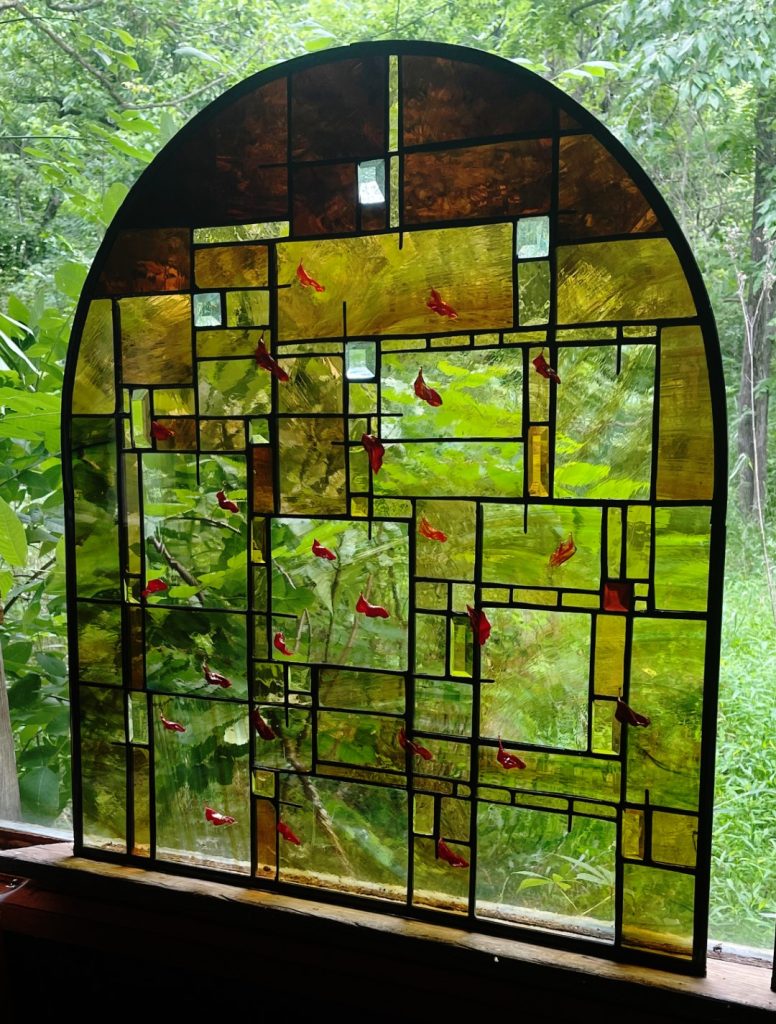




ha·la·tion
/h??l?SH(?)n/
noun
The spreading of light beyond its proper boundaries to form a fog around the edges of a bright image.
These three windows will be seen from around 20 feet away. I purposely wanted to build on the concept of halation to accentuate how light plays on our stained glass windows.
This gives the windows a feeling of movement – a kinetic approach, which I believe shows the interaction between light, glass, and vegetation.
I consider these three windows as perhaps my most artful work to date.










One of our projects is going to Florida in a couple weeks.
We’re using this beautiful hand-blown glass from Germany and some of our jewels we created using the same glass.
Next week, we’ll be able to show you the colors.


Preparing to make our bevels into colorful jewels.
We make it a point to share the journey with our clients as we create their projects. This creates a collaborative atmosphere and ensures that there will be no surprises at the end.
Below are some of the processes we’ll use on this project. I’m always amazed by how many details we have to coordinate and how creatively our minds work to pull everything together.

I create sketches, often on the kitchen table, to study the sections’ proportions and how the windows balance with each other. Drawings are worked over and over to refine the work and to help create a plan for their execution.

Finding the right glass is always a hurdle. We visited S.A. Bendheim in Wayne, New Jersey to select from their stock. This is a hand-blown glass from Germany, and in my opinion, some of the finest being made today. I look for color variation and movement in the striations. I’m also conscious of the surrounding colors and the “theme” of the window.

In this process, we will accent the “jewels” for our windows. Starting with hand-beveling glass on our 1915 machinery, we then select colors to laminate behind the bevels to create the various colored jewels. One trick we’ve learned is to pull glass from our supplier’s sample kits. This gives us a wide range of colors in a cost-effective way.

It seems like today, none of our projects are complete without including some of our flameworked leaves. Here, we will attach them as if they were blown across our windows on a windy day.






We have a commission for a retail space in New York where we have been asked to create an aviary effect with different colored birds.
Here are our initial studies, in which we want to give the illusion of flight along with the appreciation of color.

Potatoes grow well in our zip code.
Living in the country, we can purchase a pickup truckload of aged manure for $5.00. Add in all the leaves, straw, grass, and leftover plant matter, and after 35 years, our garden is like potting soil.
Every year, we plant 3 to 4 rows of potatoes. We dig a hole, stuff a handful of straw in the bottom, place the cut portion of a potato with an “eye” in the hole, and cover it up.
Then, the magic begins. Moisture, air, nutrients, and sunlight stimulate the embryo. The mixture is slightly different every year and probably different for each plant. But the point is that all those slight variations are what give us variety in size, taste, texture, and freshness. And that’s why we grow our potatoes.
Now, I’m sharing this with you because, well, art is like a potato.
It’s a mystery – an idea germinating in that three-pound organ between our ears that is teaming with billions of neurons, transmitting signals to each other at 270 MPH. We barely know how it works and have virtually no control over it, but if one gives it a little time and a good environment, it almost always surprises us with something new.

I created this mosaic 20 years ago for Mt. Zion First African Baptist Church in Charlottesville, Virginia. It’s directly behind the pulpit.
The star/cross is made of gold mirror. Each piece is on a slightly different angle, so as one walks around the sanctuary, the lights from the chandeliers flicker off of the mirror, giving the star a sparkle effect.
I’m especially fond of the white dove in the evening light.


Beveling consists of holding a piece of glass over steel wheels with grit, stone with water, cork with pumice, and felt with cerum oxide.
For the star, we used an old beveling trick in which we skipped the cork stage, so when we did the final polishing, the facets were still quite prominent.
It’s very subtle, but it gives the beveling the extra sparkle. I like to think of it as the equivalent of when furniture was made with old hand planes.

We have completed our work at Stella Maris Catholic Chapel in Ocracoke, North Carolina.
Stella Maris translates to “Star of the Seas.” We are honored to be such a significant part of Ocracoke’s first Roman Catholic chapel.





Many, many years ago, I read an article about where to find the best barbeque in Arkansas.
“Heading south on Rt. 167, about 12 miles from Little Rock, you make a left on the first dirt road, past the abandoned Buick. Follow the road about 3 miles, and you’ll see a man sitting in his lawn chair, under a pole shed, stoking his fires.”
“No signage, no menu, no pricing, but somehow you know you’re at the right place.”
For the last 41 years, this has been my business model.
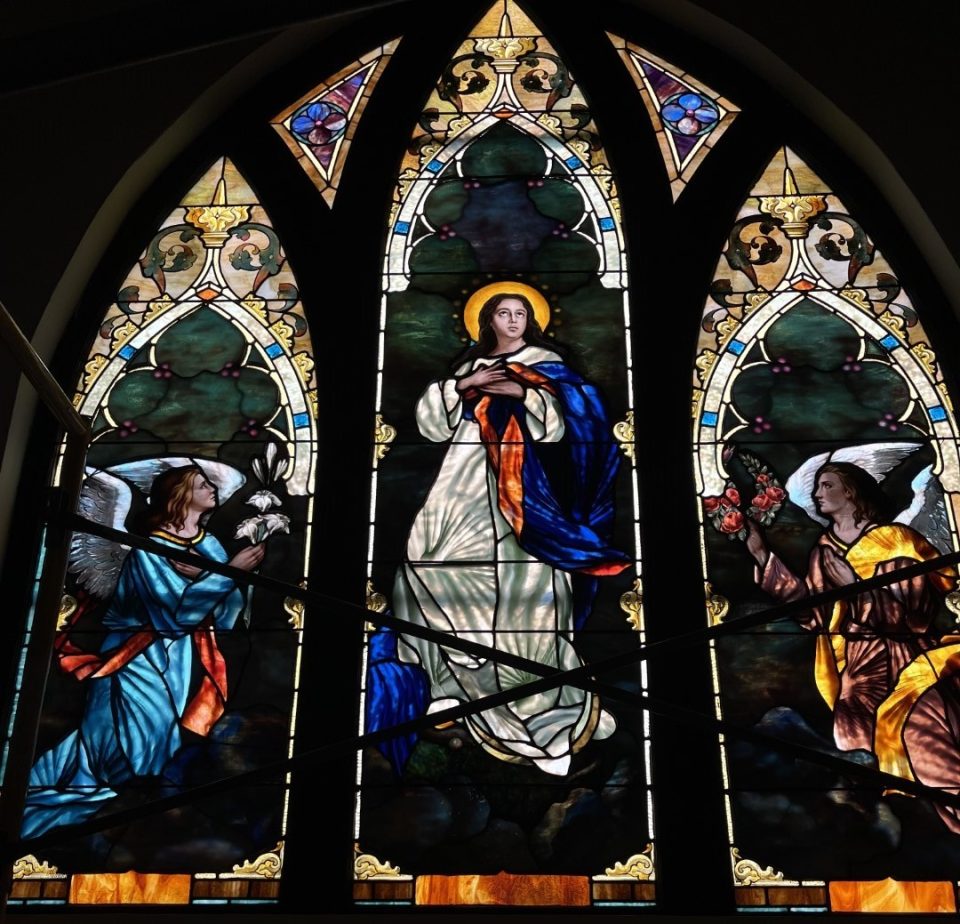
Much of what I’ve learned over the last 51 years has come from working on stained glass windows in churches.
This particular window I worked on in Ocracoke is an excellent example of first-class craftsmanship. The painting, selection of glass, and various techniques blend to create an exceptional focal point for this small chapel.

Drapery glass is created by ladling hot glass onto a heated steel table and then pushing and pulling it with various tools. I am puzzled about the round “ball” shape near the bottom. It may have come from one of the tools used to form the glass.

I was so impressed by the sensitivity to the painting in this section. I’m especially fond of the darker glass surrounding the lilies, making them a highlight of the window.
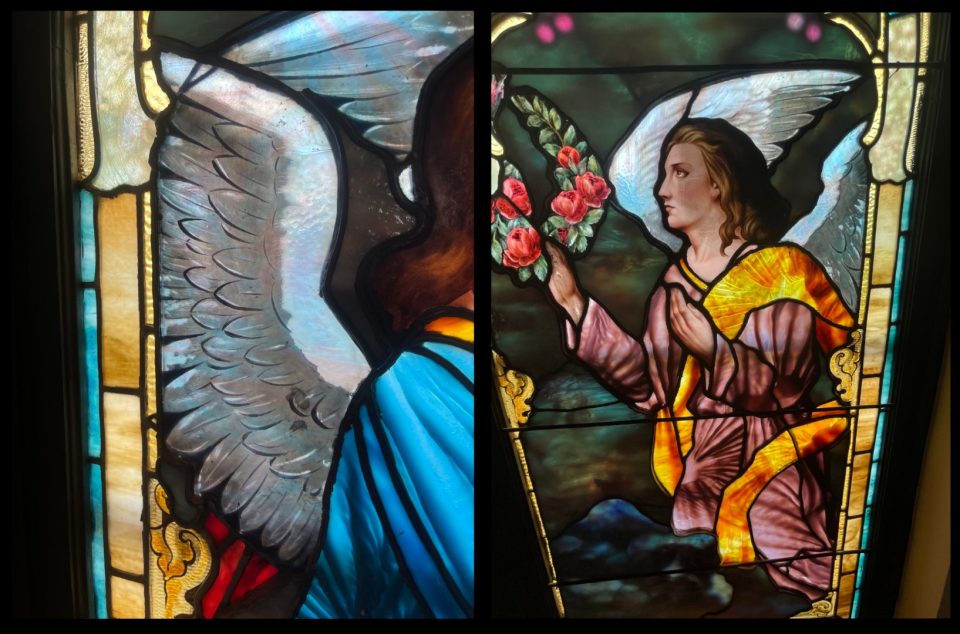
Working on the scaffolding, I was able to photograph close-ups of the wings. It is a real art to be able to paint so that the effect the artist is trying to achieve comes alive around 20-30 feet, or more, from the window.
Compare these photos to the finished window.
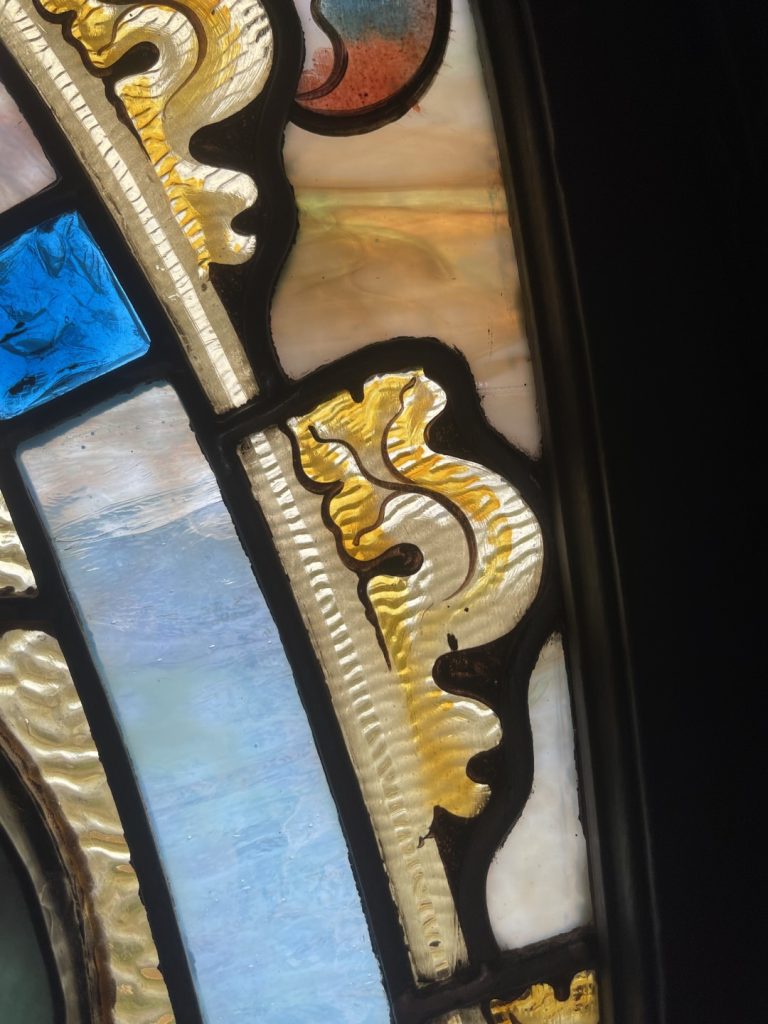
I have never seen this effect before, but the light reflecting off of this rippled glass, in the various shading of gold and beige, gave such a realistic look of the movement of light.
The blue jewel was a thicker piece of glass, I’m guessing about 3/8″, that was faceted by chipping away layers of glass, similar to the way arrowheads were made.

After I removed Mary’s face and hands, it became easier to see how the artist created the dramatic contrast between light and dark. The darker areas are two layers of glass sandwiched together, while the brighter colors are just one layer.
I often think of Rembrandt’s painting when I see windows like this—such masterpieces of thought and skill.




For the past year, we have been working on a catholic chapel in Ocracoke, North Carolina.
The donor purchased a really nice, historical window that was missing Mary’s face and hands. An artist in New England painted a replacement, but when the window was installed, it was felt that Mary was not properly represented.
My son, Daniel, and I worked together. He painted the new face and hands, and I installed them, which gave Mary her rightful presence in the window.


Windows we created for a home in Highland, Maryland, depicting the four seasons.
This was an unusual exploratory project in which we visited several of our suppliers to select glass, each with its own warehouse full of crates of glass. Each crate contains the same color, but each sheet is different. My bias is toward the more translucent glass, which means only about 3 or 4 percent of the glass interests me.
It is disappointing that by the time photography meets the internet, so much of the brilliance in the glass is lost.


Here are two windows in a series of six, of the four seasons, we are creating for a home near Washington, D.C.
These two windows show the transition from winter to spring and fall to winter. We’re also showing how the windows will look with daylight and in the evening with reflective light.

A window we are creating for a Catholic chapel in Ocracoke, North Carolina.
The background is hand-blown glass from Germany, and I found this old glass in a salvage yard that we beveled on our 1915 machinery.

As I was growing up, I was often told that in life, one can use their head or their hands.
I feel fortunate to say that I ended up using both.
As I’ve grown older, I like to think I use my creativity.




I started my college career as a forestry major. After three semesters, I realized I enjoyed the aesthetics and the environment more than the science.
So now, I incorporate my love of the forest in my work.


As we transition from winter into summer, a most beautiful time of the year.
Our shop… A home away from home.


Here is the completion of our four windows for a carriage barn.
We used a heavy reamy glass that was hand-blown in Germany. You can see the beauty of this glass come alive as the sun moves around the building.
With the addition of some bevels and our flameworked leaves and berries, our goal was to create an impressionist-type window of vines whiplashing in the wind.



We received final approval for our design, The Tree of Life, for a Synagogue.
In the last few days, we have made our patterns and are beginning by cutting the glass for the roots. The color of this window will come from the stained glass, the details and the design elements will come from painting, which will be fused into the glass to become permanent.



This is my first adventure in building a window from the inside out. I’m actually becoming quite fond of the process. It allows us to hold each section up as we build it to study our color selection.
This window represents spring, summer, and fall, and we’re going to create winter in two adjoining windows.
As I move around, working on three to four projects at a time, I find that creativity flows more easily and is less stressful.

Being a hand craftsman, it’s rare that we get to use a high-tech ”machine.”
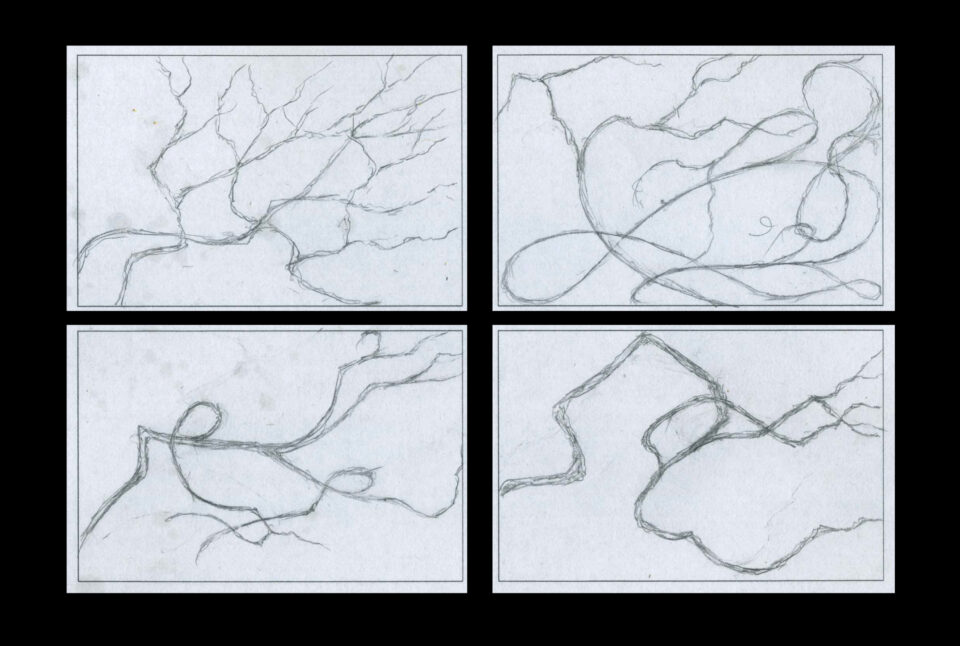


I spent most of yesterday shuffling graphite around to design four windows for one of our projects. I left the smudge marks so you can see how hard I work here!
The large picture with four drawings is how I started. The bottom two are what I’m going to present in my proposal.
I’m often at the kitchen table when I create designs like this. It takes a lot of sketching and erasing to create something that somewhat satisfies me. Staring at the drawing, I’m constantly looking for ways to build character in the lines. The way I do this is by moving around the drawing and finding little areas that need to be adjusted.
Creativity is stressful at times. It’s actually a relief sometimes to get up and empty the dishwasher and wash a few pots.

We are beginning to assemble various sections of four-season windows to study the interaction of color.
This gives us insight into how to design for the overall effect.

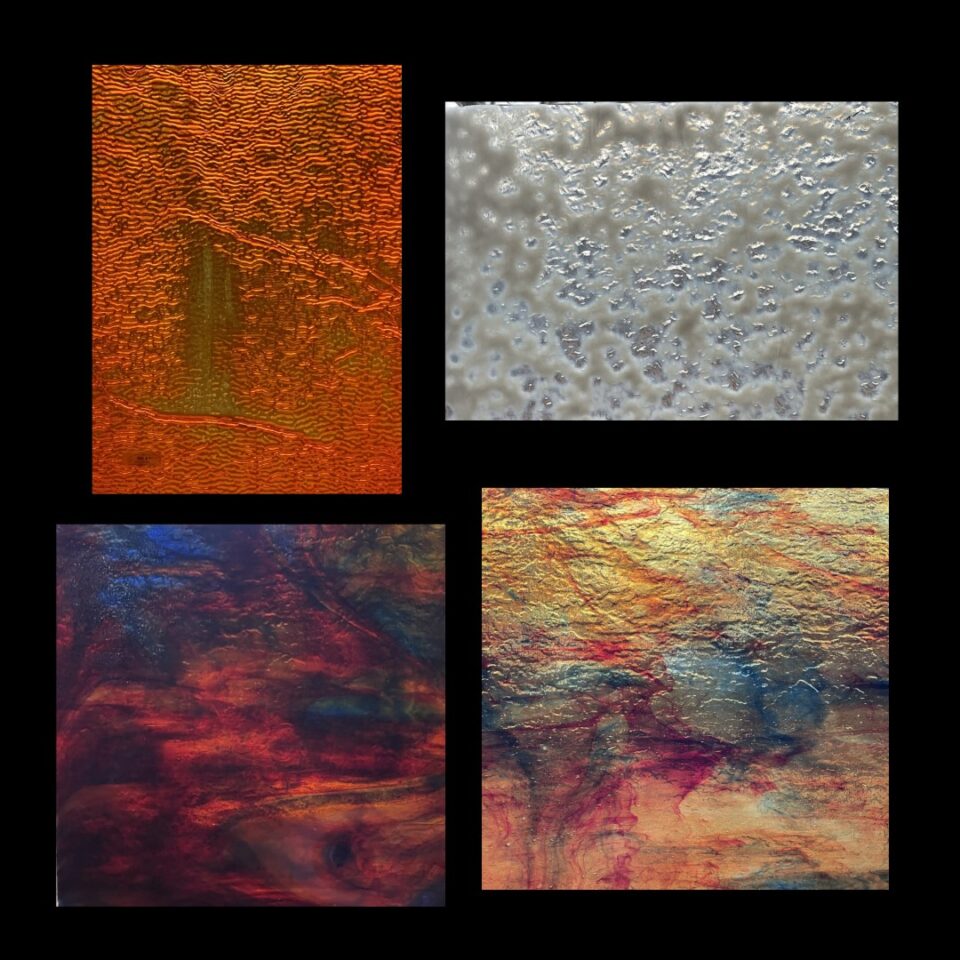

One of our current projects, involving six windows, will be to create a forest scene with elements of the four seasons.
Starting with full sheets of glass, roughly 24″ x 36″, we search for the highlights that will bring the window to life.

Last Friday, we installed our window, “Jesus Welcoming the Parish,” into St. Andrew’s Episcopal Church in Burke, Virginia. It was blessed on Sunday by Bishop Susan Goff and received glowing compliments from the parish.


Our recently completed cleaning and installation of protective covering for St. Elizabeth’s Catholic Church in Richmond, Virginia.
Due to vandalism concerns, we used Polycarbonate to protect the window, which also gave a nice reflective quality to our project.

Much discussion went into Jesus’ skin color.
The committee and we concluded that it would have been more olive-colored than white or black and that he would have most likely looked like a typical Galilean Semite of his day.
This is our finished interpretation. From my experience, this is quite a departure from most of the paintings of Jesus in stained glass windows I have seen over the years.

This is a window I made around 20 years ago for Elk Hill’s chapel, a group home in Goochland, VA.
I placed the western hemisphere on one side and the eastern on the other, with UV adhesives.
Finding the right blue for the oceans was well worth the effort.


As we move along on the painting, we add shadows to the robe to balance it with the painting of the face, hands, and feet.
The robe is finished, and we are beginning to assemble. The face requires several more paintings to achieve the skin tone of what we believe Jesus looked like.
This window was designed as an interior window beside the sanctuary entrance. I’m especially fond of the eyes looking directly into the eyes of the parishioners as they enter the sanctuary.


We start the painting of Jesus with a “ghost” tracing, which will become much lighter when we fire it around 1200 degrees.
Next, we move through the various stages using different painting techniques and firing temperatures to achieve the end results.
Our goal is to achieve the skin tone of what we believe Jesus looked like.


We updated our website this morning and included this project we did a year and a half ago on our homepage.

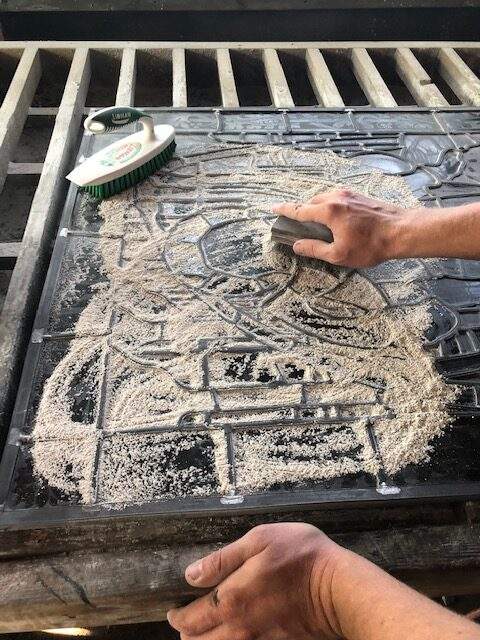
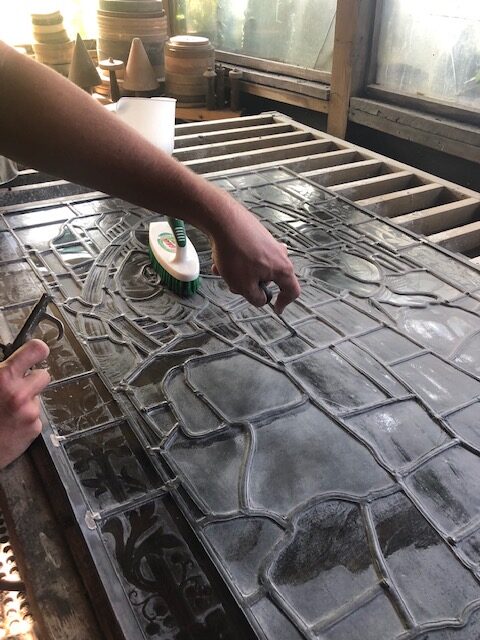

Sometimes when we have a window finished, the space we have intended it for isn’t.
This is a window we completed nine months ago, and just a few days ago received a photograph from our client after installing it.
Always a thrill for us as we consider incorporating our windows into architecture as part of our art.






We drove three hours to Frederick, MD, to visit Anything In Stained Glass yesterday. An amazing glass collection from Youghiogheny, Wissmach, Kokomo, Uroboros, Oceanside, and more.
I got to meet the owners, Paula and her husband, along with their knowledgeable staff, who helped us find the glass we needed for some of our projects. I was also impressed by their pricing and the organization of their inventory.

For the face, head, and hands to compliment the translucency of the robe, we compare past portrait studies created from various types of glass and paints. We will also apply slight shading to about 30% of the robe to balance the overall effect.
This is the best simulation in our studio of the lighting that our window will receive.
Sometimes the effect we’re after exceeds our expectations. This is one of those times.


Today we begin creating the robe from glass we’ve been collecting over the last couple of weeks.
This interior window will be lit by lights in the ceiling on both sides.
This gives a sparkle as the light picks up the highlights in the glass as one moves around the window, unlike an exterior window that is evenly lit by the sun.
The challenge is to use the four to six varieties of white glass in such a way as to bring the robe to life.











Yesterday we visited the Youghiogheny Glass Company in Collinsville, PA. A 12-hour round-trip for us. An amazing experience. I was there years ago, but they keep getting better and better. I am biased toward unpretentious companies that are turning out exceptional products. Youghiogheny is the epitome of this.
I thought you might appreciate interior shots of their enormous inventory and some of the glass we selected for our projects.
Although each crate has similar glass, each sheet is different – so we spend a lot of time selecting what is available. We focus on finding the highlights in a sheet to compliment the various elements of our design.

Every day we seem to make discoveries as we heat, push, and pull strips of glass we cut from full sheets of stained glass.

Dear friends,
Thank you for your kind comments last Thursday when I showed you the assembling photograph of this window.
I thought you would like to see how it turned out. We created this window for the Unitarian Universalist Church of Arlington in 2014.

There are times I wonder why I take on such complicated projects.
I keep telling myself that I am expanding my knowledge and skills while being paid.
It’s no secret that many of us artists “invest” most of our profit into our ongoing development as artists, and I can attest after my 50 years that this approach has worked for me.
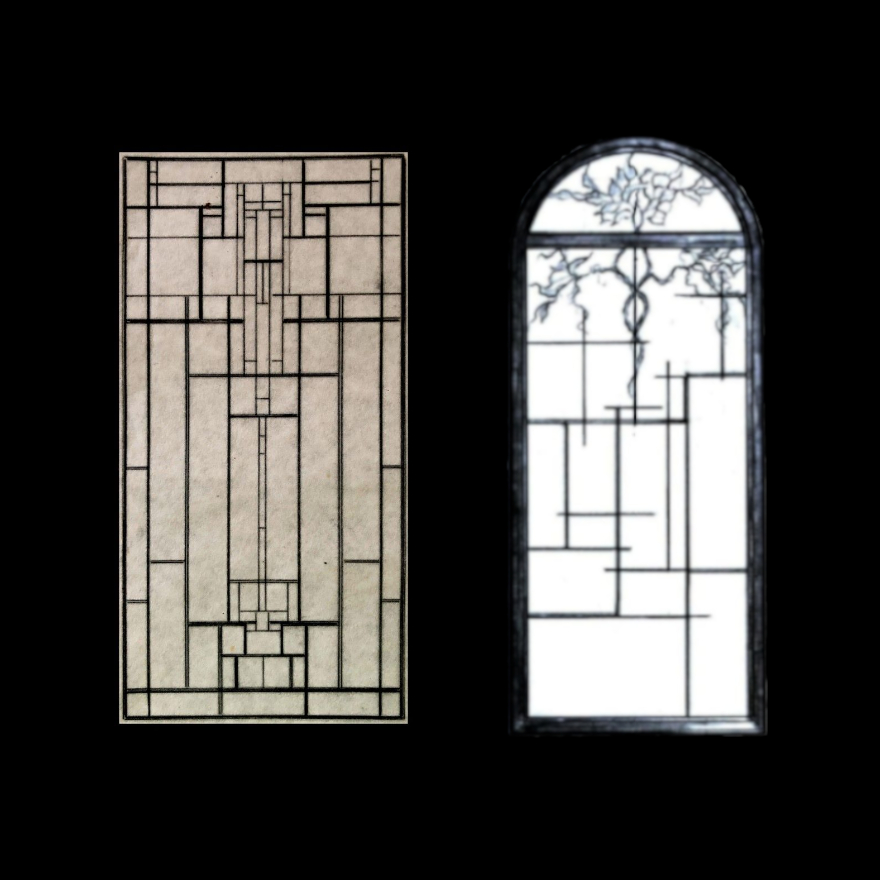
Two designs I created over 20 years ago. The one on the left would make a nice door, or perhaps a garden gate.
The one on the right was influenced by the vines growing up on the VDOT signs in the country.
A lot of thought went into the proportions and variations in the designs.

Some of the magic we’ve discovered over the years is working glass over our 1915 beveling machinery.
Cutting 3/8″ and 1/2″ glass to a pattern, and free-handing them over large steel, stone, cork, and felt wheels rotating around 200 RPM, one can create various bevels that bring character and refinement to the overall project.
We achieved the gold by using an old mirror we found that still had some of the tarnished silver. By carefully cutting and going through the beveling processes, we could preserve enough to give the pieces a special antique sparkle. Under the round bevel, we placed a piece of iridized glass to reflect light.
Over the years, we’ve discovered many techniques such as this through constant “thinking and doing, doing and thinking.” Thank you, Goethe.

Windows we made for two friends who love driving their miniature horses.

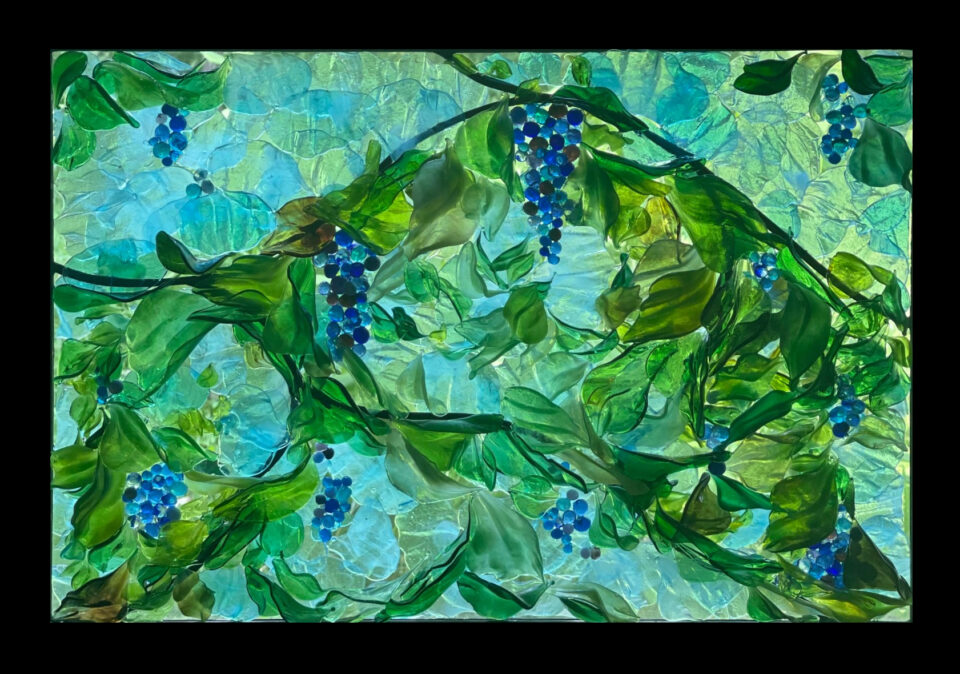
The completion of our New York transom.
14″ x 20″
This window was sheer joy when it comes to the creative process. “Thinking and doing, doing and thinking.” Thank you, Goethe.



Applying a coat of shellac to our sculpturing gives the patina a rich and finished look. A top coat of polyurethane increases the longevity of the finish.



Update on our New York transom. Still a ways to go, but incorporating some new ideas.

A jig I made from an ax handle around 35 years ago. When pieces of glass are too small to hold while breaking, the notches hold the glass firmly for accurate breaking. This is especially helpful on 1/4″ – 3/8″ thick glass.


When we create windows in which we are sculpturing the vines, we will embed nails into the design to strengthen the window. In most cases, this gives the window enough strength so we don’t have to use reinforcing bars.





The anatomy of a glass crate that’s going 606 miles by freight.
After packing the window into its initial crate with bubble wrap, we bubble-wrapped that crate before putting it into a larger crate.

A beveled glass window we created for a home in Alabama.
66″ x 25″

I got a rough sketch from one of my clients this morning who asked me to refine her drawing with my “precision tools.”
I just sent her my finished rendering along with a photo of my “precision tools.”

Every few years, while working on a church, we often come across a project that they have been trying to solve. Most of them have been large wooden doors that no longer open and shut properly.
We’re almost always able to rework the hinges, latches, and sometimes planing the doors so they work properly again.
I have found helping churches out in this way not only makes everyone feel good but is also a reminder of our craftsmanship.
In this case, we restored the weathervane for Palmyra Methodist in Palmyra, VA which was damaged in one of our recent storms.
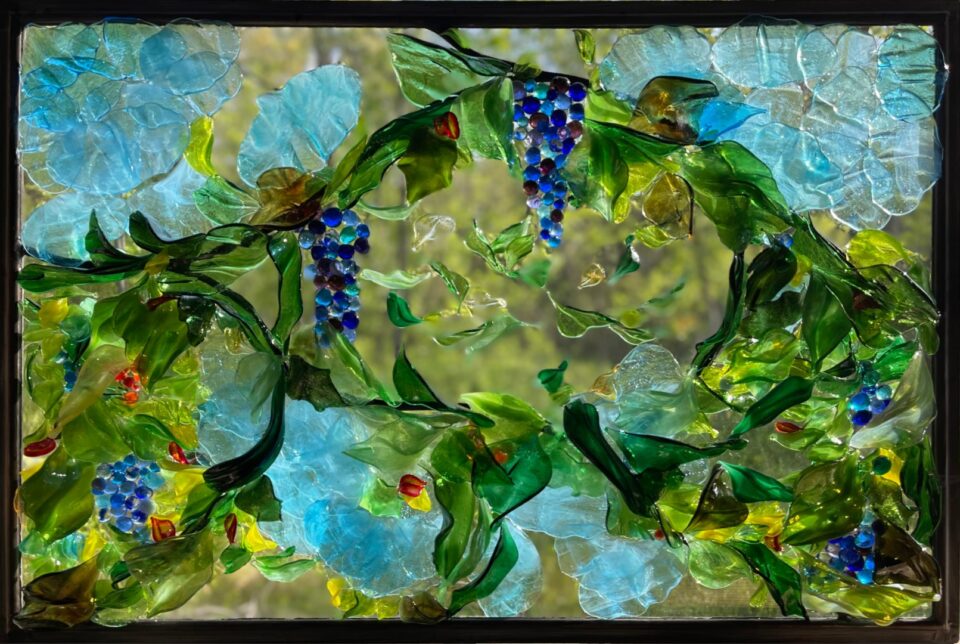
Updated progress on our New York transom window.

A transom for a home in Alabama.


Update on our grape transom. The top is bright morning sun, the bottom is approaching dusk.
Click to get the full photo.


We were so pleased to be chosen for the restoration of the art glass windows and the pleasure of working with these architects.
Please visit through the article to see this beautiful mansion – completed in 1911.





The completion of the Shanti windows.
It was created in the style of the Impressionists – the spontaneous interplay of light and color.
11″ x 39″
Sri Krishna, a Scroll, Lao Tzu, Rama Krishna, Buddha, Mary and Jesus, Confucious, and St. Francis.

Laying out patterns the old-fashioned way.


Putting the finishing touches on the 8 Shanti windows.

I was looking at my hands this morning as I was getting dressed and the thought occurred to me, that these are my “Red Badge of Courage.”
Of course, they are connected to my mind, which many of us consider the link between the two as our most valuable asset.
There is no mistaking, these are honestly earned the old-fashioned way.

A little cheerfulness to brighten this dreary day.

What I did on my four days without electricity.
Designed two windows for a carriage “barn” – 24”x48” each. On the left, trees down by the creek. The other, trees on a hillside. Colorful fall leaves on the ground with various light greens depicting the start of Spring in the branches.
Clear and various tints of blown glass from Germany, giving the window movement with its bubbles and striations will provide the background for our flame worked leaves.
Trees will be a combination of our sculptural soldering woven around bark like pieces of our flame worked glass to give the effect of reflected light and shadows.
The medallions will be a painted scene of the owner driving a carriage with her miniature horses.

The completion of one of our most “avant-garde” projects.

A recently completed transom window for a historical home in Richmond, VA.